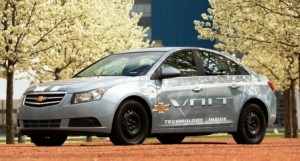
With the expansion of its battery lab, GM hopes to come up with better, cheaper batteries for vehicles like the Chevy Volt.
General Motors is investing $8 million to double the size of the battery research lab at its Warren, Michigan technical center.
The expansion of the facility, which will grow to 30,000 square feet, will not only make it easier for the automaker to improve on-site testing, but also help it develop more advanced batteries for an expanding line-up of electric vehicles it plans to bring to market in the coming years, said Micky Bly, the executive in charge of GM’s various battery vehicle programs.
The carmaker’s push into “electrification” begins in November, when it launches production of the Chevrolet Volt, an extended-range electric vehicle, or EREV. Chevy has already begun so-called pre-production of Volt prototypes and, in a Monday news briefing, GM officials confirmed that the battery car will deliver an average range of 40 miles per charge, while it is expected to yield an average 50 miles per gallon using its small internal combustion engine, once the batteries are discharged.
While GM hasn’t revealed the price for Volt, it’s expected to come in somewhere around $40,000 – though the vehicle will then qualify for a $7,500 federal tax credit. With the cost of current lithium-ion battery technology running nearly $1,000 per kilowatt hour, the 16 kWh pack used on Volt will account for about 40% of the total price.
So, for researchers at the GM battery lab, said Bly, “Our main focus is significantly reducing the battery cost (by) 50%” or more with the debut of the third-generation Volt. Exactly when that version would reach market is unclear, but where traditional vehicle lifecycles run four to five years, “With this technology,” suggested Bly, “it’s two or three.” And”that would mean cutting in half the battery cost by around mid-decade.
Longer-term, industry experts believe manufacturers will have to trim battery costs by as much as 80% by the end of the decade before electric vehicles become truly cost-competitive with gasoline-powered products.
Meanwhile, with cheaper batteries, it would help increase demand for electric vehicles, said Farah. GM is already reported to be looking at other models, beyond the Volt and its European cousin, the Opel Ampera. For his part, the project leader would only hint that the company is looking to “looking at…a number of options.” Translation: Stay tuned, as more products are likely to follow…and soon.
Of course, that doesn’t include savings on energy. Battery vehicles are expected to cost as little as one to two cents a mile to charge up, compared with 10 to 15 cents for a comparable, gas-powered model. That counts on charging during off-peak hours – at night or on weekends – using a utility that specifically offers special charging rates for battery vehicles.
Charging during peak daytime hours could significantly increase costs.
But battery vehicles will be particularly sensitive to a number of variables, noted Andy Farah, the Volt project’s chief engineer. The anticipated 40-mile range could decreate by 20% or more due to factors such as weather, terrain or a motorist’s driving style.
Range could drop significantly during cold Winters, added Bly, who noted, “It takes as much energy (using Volt’s electric heater) to keep a human warm and comfortable in a cold climate as it does to move the vehicle down the road.”
Volt will come with an onboard 110-volt charging system which, said Farah, will be able to recharge the lithium-ion pack in eight to 10 hours. That drops to about four hours using an optional 220-volt system that GM will offer as an option. The high-voltage system will have to be specially installed at a home or garage, but because of its relatively speed, the chief engineer said surveys of potential Volt customers shows a “real pull” in favor of purchasing the 220-volt system.
